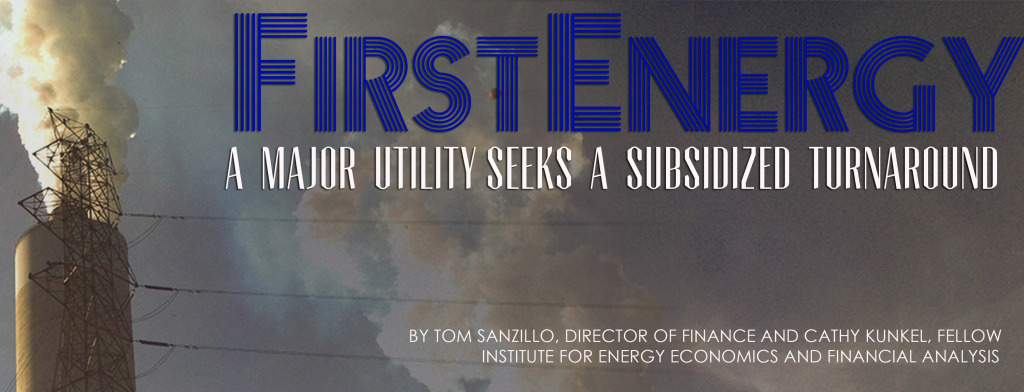Study Sees FirstEnergy Corp. Trying to Reverse Its Slide Through Regulatory Capture and Ratepayer Bailouts

 Company’s Financial Spiral Deepens; Coal-Based Business Model Falters; Plans Call for Broad Public Subsidies and Rate Increases in New Jersey, Ohio, Pennsylvania, and West Virginia
Company’s Financial Spiral Deepens; Coal-Based Business Model Falters; Plans Call for Broad Public Subsidies and Rate Increases in New Jersey, Ohio, Pennsylvania, and West Virginia
CLEVELAND, Ohio — A new financial analysis of Ohio-based FirstEnergy Corp. (FE) by the Institute for Energy Economics and Financial Analysis (IEEFA) finds FirstEnergy turning to regulatory capture and ratepayer bailouts as it struggles to reverse a deepening spiral of debt service and revenue declines.
The report “FirstEnergy: A Major Utility Seeks a Subsidized Turnaround,” was published today. It describes a company in near free fall, in part because of its untimely acquisition in 2011 of Allegheny Energy, a mostly coal-fired electricity company vulnerable to better-diversified competitors.
“The company is wedded to a failed strategy of long-term dependence on coal-fired generation. We do not anticipate any significant short-term or medium-term improvement in FirstEnergy’s financial condition,” conclude the authors, Tom Sanzillo, IEEFA’s director of finance, and Cathy Kunkel, an IEEFA fellow.
FirstEnergy, one of the largest electric companies in the United States, has more than six million customers in New Jersey, New York, Ohio, Pennsylvania, Maryland and West Virginia.
Sanzillo and Kunkel say that FirstEnergy went fundamentally awry with the acquisition of Allegheny Power, betting on Allegheny’s reliance on “merchant coal plants,” whose output is sold on the wholesale electricity market and whose profit margins are determined by wholesale prices. As development of alternative forms of energy has risen and as natural gas prices have plummeted, merchant coal plants have struggled to compete.
First Energy’s stock price is down more than 30 percent since July 2012, even as the broader stock market and energy stocks in general have soared. FirstEnergy cut shareholder dividends by 35 percent in January 2014 and increased short-term annual debt obligations by 21 percent from 2012 to 2013. Its credit rating has dropped well below those of competitors. It has written off billions of dollars in lost value from its fleet of coal plants. And while most other utilities are moving to curb coal-fired generation, First Energy continues to use coal to produce two-thirds of the electricity it creates.
Sanzillo and Kunkel show also that FirstEnergy has responded largely by focusing on a strategy of regulatory capture among state agencies, on federal subsidies, and on campaigns to thwart public policy initiatives to increase development of alternative energy and to support greater across-the-board energy efficiency.
The report cites FirstEnergy’s manipulation of renewable energy credits in Ohio; its proposed ratepayer bailouts of four plants in Ohio; its obstruction of energy-efficiency initiatives in Ohio, Pennsylvania, and West Virginia; its campaigns to raise rates in New Jersey, Pennsylvania, and West Virginia; and its reliance on federal subsidies of a coal mine in Montana.
“First Energy’s CEO has called this the ‘lost decade,’” Sanzillo said, “But it has not been a lost decade for other utilities investing in renewables and alternatives to coal. First Energy’s corporate leadership is lost, and they are asking shareholders, ratepayers and government officials to pay for their management blackout.”
Excerpts from the report:
• “FirstEnergy’s political strategy—calling for continued reliance on coal-fired and nuclear power generation and opposition to competing sources of power—is based on a mischaracterization of the fundamental challenge facing the utility industry. What worked in the past is unlikely to work in the future.”
• “FirstEnergy’s continued choice of coal as a fuel source, particularly for a utility in mid- Atlantic and Midwest markets, is increasingly risky in this new era characterized by low power prices, a glut of natural gas, rising importance of renewable energy and popular opposition to coal.”
• “While the industry as a whole is challenged by low power, natural gas prices, and the transition away from coal fired generation, most large investor owned utilities are navigating these challenges.”
• “First Energy’s reliance on subsidies and bailouts—while costly to ratepayers—will not solve the underlying downward slide of the company’s financial performance.”
The full report is here. IEEFA blog updates are here. Follow IEEFA on Twitter @ieefa_institute










